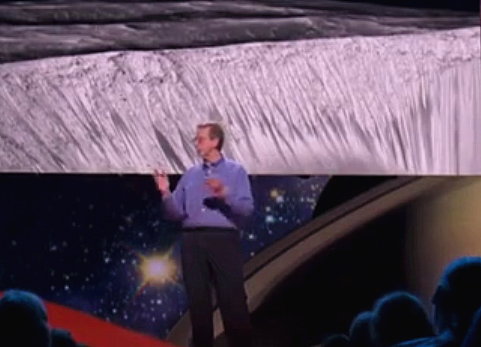A few months ago the fairy tale came true.
幾個月前,童話故事成真了!
We announced to the world that we know what these streaks are. It's liquid water.
我們向世界宣布,我們已經(jīng)知道這些條紋是什么了。是液態(tài)水。
These craters are weeping during the summer.
這些隕石坑在夏天浸出水分。
Liquid water is flowing down these craters.
這些液態(tài)水順著隕石坑向下流。
So what are we going to do now -- now that we see the water?
我們接下來要做什么--在發(fā)現(xiàn)了液態(tài)水之后?
Well, it tells us that Mars has all the ingredients necessary for life.
這說明火星擁有生命的所有必需成分。
In its past it had perhaps two-thirds of its northern hemisphere -- there was an ocean.
在過去,可能它的北半球有三分之二都曾是海洋。
It has weeping water right now. Liquid water on its surface.
現(xiàn)在它有冒出的水流。星球表面有液態(tài)水。

It has organics. It has all the right conditions.
它有有機物。它有一切合適(孕育生命)的條件。
So what are we going to do next?
那么我們接下來要做什么呢?
We're going to launch a series of missions to begin that search for life on Mars.
我們將開展一系列任務,開始尋找火星上的生命。
And now it's more appealing than ever before.
現(xiàn)在行動要比以往任何時候都更有吸引力。
As we move out into the solar system, here's the tiny moon Enceladus.
在離地球更遠的太陽系里,有一個小小的土衛(wèi)二。
This is not in what we call the traditional habitable zone, this area around the sun.
它不在我們以往公認的宜居區(qū)域內,也就是靠近太陽的區(qū)域。
This is much further out. This object should be ice over a silicate core. But what did we find?
這里離太陽很遠。這個星球應該像個被冰層覆蓋的硅酸鹽核心。但我們找到了什么?
Cassini was there since 2006,
自2006年起,卡西尼太空船就在那里,
and after a couple years looked back after it flew by Enceladus and surprised us all.
在飛過土衛(wèi)二的幾年后,再回過頭看,我們都大吃一驚。
Enceladus is blasting sheets of water out into the solar system and sloshing back down onto the moon.
土衛(wèi)二在向太陽系噴出一片片的水,再回落到它的表面。
What a fabulous environment.
多么美妙的環(huán)境啊。











